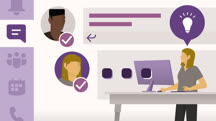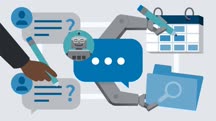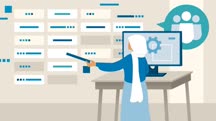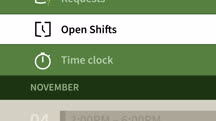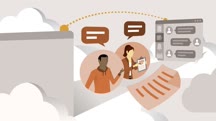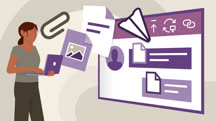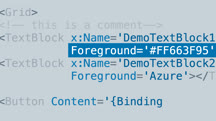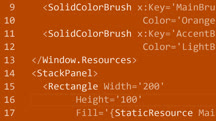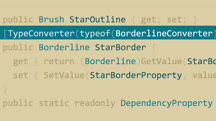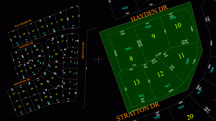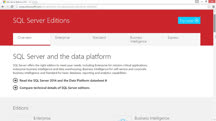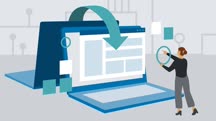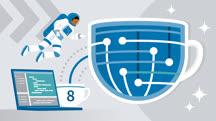کاتالوگ دورهها
طبقهها
نمایش 5,941 تا 5,960 مورد از کل 9,135 مورد.
Microsoft Teams Quick Tips (2019) (227865)
Microsoft Teams, the communication and teamwork hub of Office 365, was designed to help enterprise users meet, connect, and share their knowledge with others. In this course, instructor Nick Brazzi shares a series of concise tips that help Teams users sharpen their skills and leverage all that this communication tool has to offer. Each video is about a minute in length, so you can pick up insights in your spare moments. Learn tricks for working with messages and teams, customizing the interface, setting up notifications, running meetings, and more.
Microsoft Teams Tips and Tricks
Learn tips and tricks to be more efficient with Teams, the chat and collaboration app that is becoming the hub of Microsoft Office 365.
Microsoft Teams Tips Weekly
Learn to be more productive and efficient with Microsoft Teams in just a few minutes each week.
Microsoft Teams: Automating with Bots, Connectors, and Flows (231673)
Did you know you can automate many tasks in Teams? Microsoft Office Apps and Services MVP and Microsoft Certified Trainer Heather Severino teaches how to do more in less time with bots, connectors, and flows. Heather starts by showing how to speed things up with bots, including how to quickly find colleagues and projects, automate meeting scheduling, create polls and surveys, and track team progress. Next, she shows how to pull in relevant content with connectors, including pulling pertinent news stories and RSS feeds. She demonstrates creating flows with Power Automate, which allow you to post messages to a Teams channel or conversation automatically whenever a new Planner task is created, a new Forms response is received, an Outlook email arrives, or a new tweet matches a particular hashtag. Finally, Heather shares where to go for more help in automating Microsoft Teams.
Microsoft Teams: Building Custom Apps with the Dataverse (232676)
For many users and organizations, Microsoft Teams isn’t just for chatting with coworkers and team members, it’s the new work hub. You can hold meetings, share files, and access frequently used apps, all within Teams. In this course, Gini von Courter shows how to take Teams to the next level by building custom apps using Microsoft Power Apps and the Microsoft Dataverse. Custom apps in Teams allows specific members of a group or organization to have a data-rich experience while using Teams, such as sharing table-based data, collecting data from multiple sources, aggregating data across the web, and even making mobile data-based apps that launch inside of Microsoft Teams. Best of all, with Power Apps, you don’t need to write a single line of code to create an application. If you can create a table in Excel or a list in Teams, you have everything you need to create apps in Teams.
Microsoft Teams: Learning Shifts for Firstline Workers
Keep in sync with your employees and coworkers using Microsoft Teams. Learn how to create, view, and modify staff schedules for firstline workers using Teams.
Microsoft Teams: Organizing Your Personal Life (209743)
With its consumer version of Microsoft Teams, Microsoft offers a way to get organized at home. Instructor Heather Severino walks you through how you can use the features and tools in Teams. Heather is a Microsoft Certified Trainer and Microsoft Most Valuable Professional for Office Apps and Services. In this course, learn how to invite friends and family to Microsoft Teams, start and manage chats and group chats, and use Activity and Search to stay up to date with communications. Find out how to invite people to an online meeting, how to join someone else’s meeting, and how you can access and share files with OneDrive. Explore how Tasks can help you keep track of personal and shared items on your to-do lists. Observe how to start and answer audio and video calls, as well as how to capture and share photos. In conclusion, discover how to update app settings, reorder tabs in the app, and find the help and resources you need.
Microsoft Teams: Successful Meetings and Events
Learn how to schedule, facilitate, and participate in meetings using Microsoft Teams.
Microsoft Teams: Working with External Guests (231656)
You can use the communication and collaboration features of Microsoft Teams with anyone, whether or not they’re inside your organization. Working with external users can be tricky, but in this course, instructor Nick Brazzi covers all the bases. Nick clearly defines what a guest user is and how to invite one to join your organization. He shows how a guest user accepts an invitation, sets up a Microsoft account, and signs into Teams as a guest. He explains limitations for guest users and shows you how to identify them in Team conversations and meetings. Nick teaches you how to invite guest users to meetings and how to join or start a meeting as a guest user. In conclusion, he shows you how to remove guests from a team and from a Microsoft 365 organization.
Microsoft Teams: Working with Files (215608)
Microsoft Teams is changing the way we work. With Teams, you can share files in a one-on-one chat, during a Teams meeting, or by posting to a department’s Teams channel. Although many users are sharing and storing files with Teams, they may not know the best way to find previously shared files or how to manage file permissions. In this course, LinkedIn Staff instructor Nick Brazzi highlights the best ways to store, organize, edit, and share files using Microsoft Teams. Nick begins with a quick overview of how file sharing works in Teams. He then demonstrates how to view and edit files, including how to set and adjust file permissions. Nick shows how to manage your file libraries within Teams to ensure contents are organized efficiently. He also covers the most effective way to share your screen during a Teams meeting, showing techniques for PowerPoint presentations and other file types. To wrap up, Nick offers tips for managing files in the Teams mobile app.
Microsoft XAML: 1 Core Concepts
Learn the basics of XAML, the XML-based markup language for creating better user interfaces for Windows applications.
Microsoft XAML: 2 Content and Properties
Explore how XAML treats content within XML markup and the dependency properties framework, which enables services such as data binding and animation in Windows applications.
Microsoft XAML: 3 Type Converters and Resources
Find out how to use type convertors and markup extensions to convert XAML properties to .NET properties and create, organize, and consume XAML resources.
MicroStation 3D Essential Training
Get started with MicroStation V8i SELECTseries. In this course, acquire the 3D tools and techniques you need to tackle design projects of any size or complexity with MicroStation.
MicroStation V8i: References
Learn how to work with the reference files feature in MicroStation, which allows you to display another design file over your MicroStation design file.
Microstation: AccuDraw
Discover how to leverage AccuDraw, a collection of aids for positioning and drawing precisely in MicroStation V8i, for a more productive CAD workflow.
MicroStation: Plotting in V8i
Learn about plotting with Bentley MicroStation V8i. See how to print single files, batch print multiple files, and automate the print environment to improve efficiency.
Migrating Access Databases to SQL Server
Leverage what you already know about databases to migrate Access tables to SQL Server, and gain access to a more powerful toolset.
Migrating between Windows and Mac Computers (226437)
Making the switch from Windows to Mac, or vice versa, can be intimidating at first, but the process is usually easier than people expect. Learn about the similarities and differences between the two operating systems in this comprehensive course with Nick Brazzi. Nick explores the software and demystifies macOS and Windows terms that can be confusing for first-time users. He also covers the setup, configuration, and effective use of a mouse and keyboard, including wireless bluetooth setup and interacting with gestures. This course also covers transferring files and email between Windows and Macs, and steps for installing and uninstalling new applications. While switching from one system to the other may seem daunting, after this course you may discover that, as Nick points out, Windows and macOS have more similarities than differences.
Migrating beyond Java 8
Discover how to migrate your Java 8 applications to the latest versions of Java. Explore new features in Java 11 to 14 and get tips for conducting a seamless migration.
